CHINA'S FOREIGN RESERVES
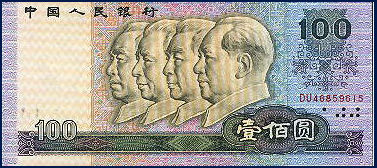
front of old 100 yuan banknote
Foreign reserves topped $3 trillion in March 2011, after having increasing 25 percent in the past year alone. This was more than a third of the $9.1 trillion in foreign exchange held by all central banks that reported to the IMF in 2009 and more than Japan, Russia, South Korea, Taiwan. Saudi Arabia and all the euro-zone countries combined. China added $200 billion in the previous three months alone. This increases occurred despite promises by Beijing that it would try to balance its trade and investments with the United States and other nations.
Foreign reserves soared to $3.2 trillion in July 2011 as Beijing intervened in currency markets to control the yuan despite pledges to allow more flexibility. Peter Navarro wrote in the Los Angeles Times, “To put these dollar reserves in perspective, that's more than enough money for China to buy a controlling interest in every major company in the Dow Jones Industrial Average, including Alcoa, Caterpillar, Exxon Mobil and Wal-Mart, and still leave billions to spare.” The next closest holder of foreign reserves is Japan’s with around $1 trillion; open Western nations such as the United States hold comparatively little.
China’s foreign reserves were only $80.8 billion in 2001. Edward Chancellor wrote in the Wall Street Journal: “In 1974, the future Chinese premier Deng Xiaoping led a large delegation to the United Nations in New York. Chinese officials discovered, as they prepared for the expensive trip, that the could muster only $38,000 in foreign cash. In those days there were no banks in China except the People's Bank of China, then a department of the Ministry of Finance. Foreign reserves reached $2.13 trillion in July 2009 up from $1.86 trillion at the beginning of the year. At this time the reserves were increasing at a rate of 5 percent, or about $40 billion, a month. The increase occurred even though China was suffering from a severe trade slump, suggesting the money was coming from foreign investments.
China’s foreign reserves were only $70 billion on 1995. China massed its first $100 billion in foreign assets, mostly held in U.S. dollars, in 1996. By 2001 it held $200 billion. By 2006 it passed the $1 trillion mark.
The source of the money in the foreign reserves is its trade surpluses with the United States and other nations. Foreign exchange reserves hit $1.68 trillion in March 2008, compared to $1.07 trillion in at the end of 2006. The 2006 figure was $247 billion, or 30.2 percent, more than the end of 2005 and almost $500 billion more than 2004. Booming exports are the primary reason for such a large figure. . Foreign exchange reserves reached $1.181 trillion in June 2008. The rate was due to booming exports and trade and investment but also from an influx of “hot money” from speculators betting that value of the yuan will keep rising. So much money in dollars was flowing into China the government took efforts to control out of concern to fuel inflation.
Even though there has been some talk that China might abandon the dollar for the euro, it continues to put between 65 percent and 70 percent of it money into dollars. How does the Chinese government get such large reserves of dollars? When a Chinese company does business with an overseas buyer it is generally paid in dollars but these dollars are little use in China so the company takes them to bank and trades them for Chinese yuan, which it can use to pay workers and suppliers in China. Chinese banks are required to exchange the foreign currency for Chinese currency with the People’s Bank of China (RMB), the China equivalent of the Federal Reserve Bank. In this way dollars accumulate in the RMB at a rate of over a $1 billion a day
Some economists have recommended that the Chinese central bank buy gold and oil as a hedge against a suddenly falling dollar. China only has one percent of its reserves in gold compared to 70 percent in the United States. China has begun asking some of its trade partners to pay in euro as a way of diversifying and not being so reliant on dollars.
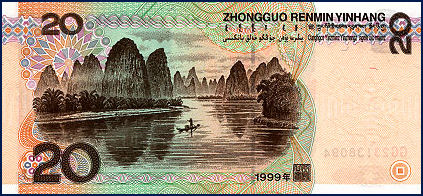
back of 20 yuan banknote
Meaning of China’s Foreign Reserve Holdings
Foreign exchanges holding are a measure of economic links with other countries and a manifestation of imports and exports, investment and speculative “hot money” flowing into local markets.
Howard Schneider wrote in the Washington Post, “Despite the store of wealth China remains deep in the ranks of the developing world, with per capita annual income of $3,000 and extensive rural infrastructure needs that draw the help of such organizations as the World Bank. The money can’t be easily spent inside the country without adding to inflation but could be used for imports or invested overseas, as some of it is through China Investment Corp., the nation’s sovereign wealth fund. A rising exchange rate would ease the pace of reserve accumulation a different way, by spreading spending power throughout the population.
The currency policy boosts the fortunes of export companies by keeping prices lower than they otherwise would be. But it also helps maintain a large trade and investment surplus, plus a flow of money being bet that at some point the yuan will rise in value — all components in the growth of China’s reserves. Some here argue that the large stockpile makes little sense in a country with pressing development needs.
With much of the money simply funneled into low-yielding U.S. Treasury securities, “on the whole, we have failed to use these resources to improve living standards,” said Yu Yongding, an economist at the Chinese Academy of Social Sciences and former adviser to the PBOC’s monetary policy committee. “As a developing country, we should not be exporting capital.”
Dynamics Behind China’s Huge Foreign Reserves
Harvard history professor Niall Ferguson told the Global Viewpoints Network: “As the Chinese growth strategy was based on export-led growth, they had no desire to see their currency appreciate against the dollar. So they intervened consistency in currency markets, and as a result ow gotten [huge] international reserves...The unattended effect of this was to hlp finance the U.S. current account deficit at very low interest rates . Without it, its hard to believe that the U.S. financial markets wold have bubbled the way the did in the period 2002-2007.”
In March 2009, at the height of the global slump, Chinese Premier Wen Jibao expressed concerns about “the safety” of it bond investments in the United States. In a question and answer session at Beijing University in June, U.S. Treasury Secretary Timothy Geithner tried to reassure one questioner that China’s investments in the U.S. government were “very safe.” The students laughed.
China continued to but U.S. bonds in large quantifies even during the global slowdown If China were to get cold feet about purchasing U.S. Treasury securities the affect could be devastating for the U.S. economy. Interest rates would rise, making it more expensive for the United States to finance its stimulus packages and homeowners to pay off mortgages.
China is concerned about large U.S. deficits which lead to inflation, which will reduce the value of China’s dollar-denominated holdings. In any case China is being very discreet in discussing foreign currency matters because it doesn’t want to encourage speculation and cause a panic in currency markets.
In September, China announced it would buy $50 billion in bonds from the International Monetary Fund.
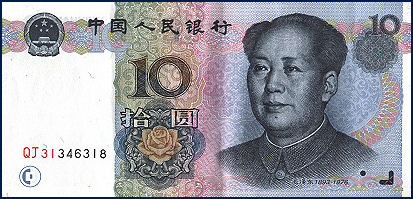
front of 10 yuan banknote
Managing Foreign Reserves in China
The People’s Bank of China — China’s central bank — had foreign reserves in 2006 of $1 trillion , the world’s largest. It made a profit of $29 billion, far larger than any other national bank and about three fourths of what Exxon-Mobile made. Most of the foreign currency in China’s central bank is from foreign investment in China and the sale of Chinese exports.
The reserves are overseen by the State Administration of Foreign Exchange (SAFE), which is headed bu a 46-year-old women Hu Xiaoloan (2005). The brain trust of the SAFE is reportedly two dozen traders chosen by showing extraordinary mathematical brilliance at China’s top universities. They work in a rented room on the forth floor of an insurance building sitting in front of computers around a golden globe with lapis lazuli seas.
About 70 percent of China’s U.S. investments and holdings are in low-yield Treasury notes and federal agency bonds, regarded as among the safest investments in the world. Most are purchased by the People’s Bank of China (RMB) with bids at auction for U.S. Treasury notes.
Hot Money in China
Hot money is a term that describes short-term speculative funds from overseas. Some of it flows into China via underground banks and other illegal financial entities and through padding of trade and investment bills.
By some estimates $1.7 trillion in hot money has entered China since the yuan was revalued in July 2005. Hot money has been blamed for creating real estate and stock bubbles. China’s State Administration of Foreign Exchange estimated that $35.5 billion in hot money flowed into China in 2010.
In July 2008 new regulations were put in place to control the hot money trade by requiring companies to send foreign currency to designated bank accounts and not allowing them to change yuan until records have been verified by Chinese financial authorities.
Chinese Public Perceptions of China’s Large Foreign Reserve Holdings
David Pierson wrote in the Los Angeles Times, “Despite the codependence with the U.S., state-run media have painted China as a maltreated lender, subject to the whims of a reckless Washington government that continues to drive down the value of the dollar to the detriment of its largest foreign creditor.” Beijing's dollar reserves are seen by many ordinary Chinese as a symbol of the nation's toil over three decades of economic reforms.
As one micro-blogger named Lin Junghua put it: "China's reserves are the fortune accumulated through 30 years of hard work by the Chinese people." "Americans got cheap products, the Chinese government got U.S. dollars and Chinese people only got devalued [yuan] and worthless personal assets," wrote another micro-blogger. [Source: Los Angeles Times
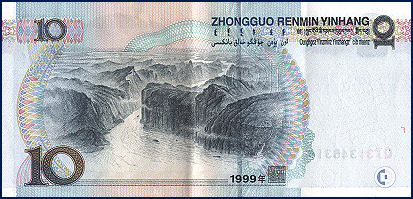
back of 10 yuan banknote
Chinese Has Too Much Money
When foreign reserves topped $3 trillion in March 2011, Chinese central bank governor Zhou Xiaochuan said that the country was, in effect, suffering from too much money. “Foreign-exchange reserves have exceeded the reasonable level that our country actually needs,” Zhou said, and the continued buildup adds to the risk of inflation and makes it difficult for the country to manage its monetary policy. The admission amounted to an acknowledgment that some of Beijing’s core economic policies are causing trouble. [Source: Howard Schneider, Washington Post , April 19 2011]
Howard Schneider wrote in the Washington Post: “According to media accounts, Zhou stopped short of any recommended remedy. But the continued accumulation of reserves is closely linked with the country’s practice of keeping its exchange rate low and relatively stable against the dollar. Zhou’s comments reflect an intensifying dilemma over the trade-offs involved — particularly the risk of inflation and the rising interest rates and other measures that the People’s Bank of China is imposing to try to keep prices under control.
“China has reached a monetary policy stalemate,” in which traditional banking measures have not curbed inflation but authorities are unwilling to let the currency appreciate as another way to address the problem, Glenn B. Maguire, chief Asia economist with the financial services firm Societe Generale, wrote in an analysis
In a recent study, the International Monetary Fund estimated China has accumulated perhaps twice or more the amount of foreign reserves needed for traditional purposes, such as buttressing the economy in a crisis. Schneider wrote: “To stabilize the value of the Chinese currency, the dollars coming into China must be drawn back out of the financial system — and in a way that does not expand the local money supply more than authorities wish. The central bank does that by having China’s major banks turn over foreign exchange in return for interest-bearing central bank securities. Although that keeps the exchange rate steady, it means that capital in effect is locked up in the central bank, where it cannot be lent or put to use in the economy.
Perhaps a quarter or more of China’s money supply “is now frozen or inactive,” Fan Gang, head of China’s National Economic Research Institute and a former member of the central bank’s monetary policy committee, wrote in a recent essay that advocated both a higher exchange rate and social, tax and other reforms that would raise Chinese household spending.
United States’ and China’s Economic Relationship
Harvard history professor Niall Ferguson coined the term “Chimerica” to describe the way the Chinese and American economies have become fused. He told the Global Viewpoints Network: “the Chinese did the saving, the Americans the spending. The Chinese did the exporting, the Americans the importing. The Chinese did the lending, the Americans the borrowing.” Luo Ping, director-general of China’s Banking Regulatory Commission, said, “We hate you guys, but there is nothing much we can do.”
China holds large amounts of the United States’ foreign debt in the form of U.S. Treasury notes and could cause great damage to the U.S. economy were it to suddenly unload them. In April 2006 a call by a Chinese lawmaker Chen Siwei, who often speaks on economic issues, for China to sell of its U.S. debts rattled the dollar on world markets. China’s holdings of U.S. debt reached a record $1.175 trillion in February 2011.
When the United States cuts taxes or launches stimulus measures it is essentially borrowing the money from China. On the impact of China’s huge holdings of U.S. debt, Ferguson said, the question then becomes, how the relationship will evolve or even survive as Americans has spent all they can and can no longer borrow any more and Chinese have become have become fed up with American profligacy like “a spouse with a maxed out credit card” but still needs Americans to buy its products to provide jobs in the trade sector.
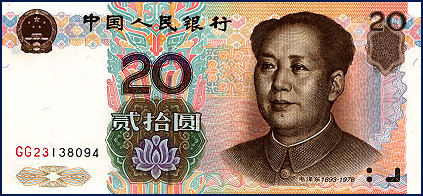
front of 20 yuan banknote
Trillion Dollar Debt
China has huge amounts of money ($1.4 trillion in late 2007) parked in U.S. Treasury notes. China is the second largest investor if U.S. Treasuries. This means that every person in the United States in effect has borrowed $4,000 from China. All this Chinese money has kept the American economy humming along at a comfortable rate and masked over its structural problems. It has also means that Chinese has been living at a lower standard of living than they otherwise would have if the money had been invested in China. As it stands China only consumes about half of what it produces. [Source: James Fallows, Atlantic Monthly]
In September 2008, China surpassed Japan as the top holder of U.S. Treasury securities with China possessing about $585 billion in U.S. Treasury holdings, more than double what it had in 2005, and Japan having $573.3 billion, down from a peak of $699 billion in August 2004. In 2009, Japan reclaimed the position of the largest holder of U.S. securities with $798.8 billion of them, compared to $755.4 billion for China.
Why doesn’t China use the money at home to build better hospitals, schools and road? The main reason is to keep inflation under control and maintain growth, If more of this money was spent at home, it would put more money in circulation in China and this would likely increase inflation which might create instability by significantly reducing the purchasing power or ordinary Chinese and make them angry at the government. By parking money in U.S. treasury notes China also fuels it export-driven economy by keeping the value of the yuan low,
One question that arises is what would happened if China suddenly decided to unload all its dollars and U.S. Treasury notes, an act that has been described as economic terrorism. It could cause global economic chaos. Many experts have argued that this would never happen because China would suffer as much as the United States as the value of it dollar holdings would plummet as they were being unloaded and factories depend on consumers paying with dollars. Laurence Summers calls this policy “the balance of financial terror” and compared it with the “mutually assure destruction” idea of the Cold War n which neither the United States or the Soviet Union would launch a nuclear attack against the other because they themselves would be destroyed.
Lack of Options Other Than Buying U.S. Securities
Beijing has few options other than to continue to purchase United States Treasury bonds. Because China has about $3 trillion in foreign exchange reserves, there are few places big enough to safely invest those holdings outside of United States Treasuries, even though its looks like they may lose value.
There really isn't a better choice than U.S. Treasury bonds," wrote Huang Yiping, professor of economics at Beijing's Peking University, in a commentary published Monday in the influential financial magazine Caixin. "The basic requirements for foreign reserves are safety, stability in value and liquidity. Although U.S. Treasury bonds might not meet the first two criteria right now, the problem is still that we do not have a better choice." [Source: David Pierson and Don Lee, Los Angeles Times, August 08, 2011]
William Pesek of Bloomberg wrote: “Many investors still see China’s monster currency stash as a strength. They reason that China is fortified against financial Armageddon. In reality, China is trapped and struggling to find exits that don’t exist. Sell dollars for Greek debt? Right. Swap into Italian commercial paper? Perhaps not. Find enough spare Swiss francs to diversify into? Good luck. There’s always Japan. Two immediate problems come to mind. One, 10-year bonds yield a piddling 1.06 percent, about a third of the return on comparable U.S. bonds. Two, with about 95 percent of Japan’s debt outstanding tucked under tatami mats at home, China couldn’t get its hands on enough to make the exercise worthwhile. Bond markets elsewhere in Asia are either too small or too illiquid to help.”
David Pierson and Don Lee wrote in the Los Angeles Times, “Beijing has bought gold, European and Japanese bonds and stakes in overseas companies, but the move to diversify has been tiny and remains piecemeal compared with the magnitude of available U.S. debt. Nor is any other currency available to take on the dollar's role. Neither the Japanese yen nor the Swiss franc, two other traditional safe-haven currencies, is as deep as the dollar. And Europe's fiscal crisis dampens enthusiasm for its government debt.The lack of options has rendered Beijing's promises to diversify its holdings largely empty. Efforts to internationalize the yuan and diminish the role of the dollar are nascent at best.
Analysts say that if China pulls back from purchasing Treasuries, the dollar would weaken and America’s borrowing costs would rise sharply, but that would also hurt China’s existing holdings.
China Buys Hard Assets Rather than U.S. Treasury Securities
In 2010, year, for the first time ever, China has been investing more overseas in assets like iron, oil and copper than it puts into U.S. government bonds. Leslie P. Norton wrote in Barron’s: “China in this year's first half spent $31 billion on hard assets, compared with $23 billion on Treasuries and other U.S. government bonds. Experts say China's investments in each of these asset classes will total about $55 billion for the full year. But even a tie marks a major turnaround from China's previous practices. For many years, the mainland spent next to nothing on hard assets abroad, while its purchases of U.S. government debt ranged as high as $100 billion a year.” [Source: Leslie P. Norton, Barron’s, November 11, 2010]
“Why does China now have such a voracious appetite for hard assets? The most frequently cited reason is its need to feed its rapidly expanding industrial base. True enough. But it's also important to see China's reduction in Treasury purchases and its sharp increase in hard-asset deals as part of its currency strategy. It's widely accepted that the Chinese currency, the yuan, is undervalued against the dollar, perhaps by as much as 40 percent. Based on moves made in the past few years, it seems likely that Chinese officials will let the yuan, which is pegged to the dollar, rise by 2 percent to 3 percent against the greenback each year.
“In the face of such a weak dollar, it doesn't make much sense to keep investing heavily in Treasuries or any other dollar-based asset. The annual interest payments can easily be outweighed by the loss in the dollar's value. There are serious concerns in Beijing, too, about the creditworthiness of U.S. debt. The smarter bet is to invest in assets that are likely to hold their value, or even increase in value, as the dollar continues its slide.”
“China has been accumulating hard assets at a rapid clip for several years. Among this year's biggest deals, CNOOC (ticker: CEO), China's largest offshore oil producer and one of its most powerful state-owned companies, is spending $2.2 billion for shale acreage in the U.S. owned by Chesapeake Energy (CHK) and $3.1 for 50 percent of a unit of Argentina's Bridas Energy. State Grid Corp. of China plowed $1 billion into Chilean copper deposits. Sinopec (SNP) coughed up $4.6 billion for 9 percent of ConocoPhilips (COP) — and another $7.1 billion for 40 percent of Repsol's (REP) Brazilian unit.”
“When China can't buy the business, it buys the underlying commodity. China's Sinofert, after weighing and dropping a bid for Potash Corp. (POT) to counter BHP Billiton's hostile offer, announced last week that it would buy $2.2 billion of the key fertilizer ingredient from Canpotex, the monopoly whose three members include Potash. Chinas's investments in hard assets are growing quickly. In June, even as the mainland dumped a net $15.6 billion of U.S. Treasury and agency bonds, it also bought $1.1 billion in Canadian minerals and Mozambique coal deposits.
"China is upgrading its industries, and all are very heavy users of these materials," Lu Kang, deputy director general of the Ministry of Foreign Affairs in Beijing, told Barron’s. Adds He Ning, director general of the Ministry of Commerce in Beijing: "China is starting to make overseas investments as a return to the world. It's just a start." As such deals become more numerous, says He, "people will no longer pay attention."
For its part, China must maintain a balance between investing wisely and making sure the U.S. remains economically healthy enough to absorb Chinese exports. That consideration will become less important as China further expands its own domestic market and becomes less reliant on exports.
China's 1,054 tons in gold reserves, for example, is worth less than 2 percent of the country's $3.2 trillion in total foreign reserves — of which about 75 percent are estimated to be in dollar-denominated assets.
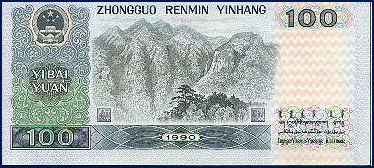
back of old 100 yuan banknote
Hidden Wealth in China
An August 2010 study by the Credit Suisse Group revealed that China’s households hide as much as $1.4 trillion of income not reported in official figures. The figure is huge — equal to 30 percent of GPD. The report also said 90 percent by the nations richest people hide much of their wealth. Much of the income may be “illegal or quasi-illegal” the study said.
William Pesek of Bloomberg wrote: “It should no surprise that a nation growing 10 percent has a healthy gray economy running in parallel, That’s what happened when an all-powerful top-down government mixes with vast supplies of capital.”
“There may be both good and bad news in the above study...The good: it lends credence to the domestic-demand story for Chinese growth. It turns out the average urban disposable household income is 90 percent more than official figures. The bad: China’s rich-poor gap may be much bigger than we realize and this could lead to social unrest.
Image Sources:
Text Sources: New York Times, Washington Post, Los Angeles Times, Times of London, Yomiuri Shimbun, The Guardian, National Geographic, The New Yorker, Time, Newsweek, Reuters, AP, Lonely Planet Guides, Compton’s Encyclopedia and various books and other publications.
Last updated November 2011
